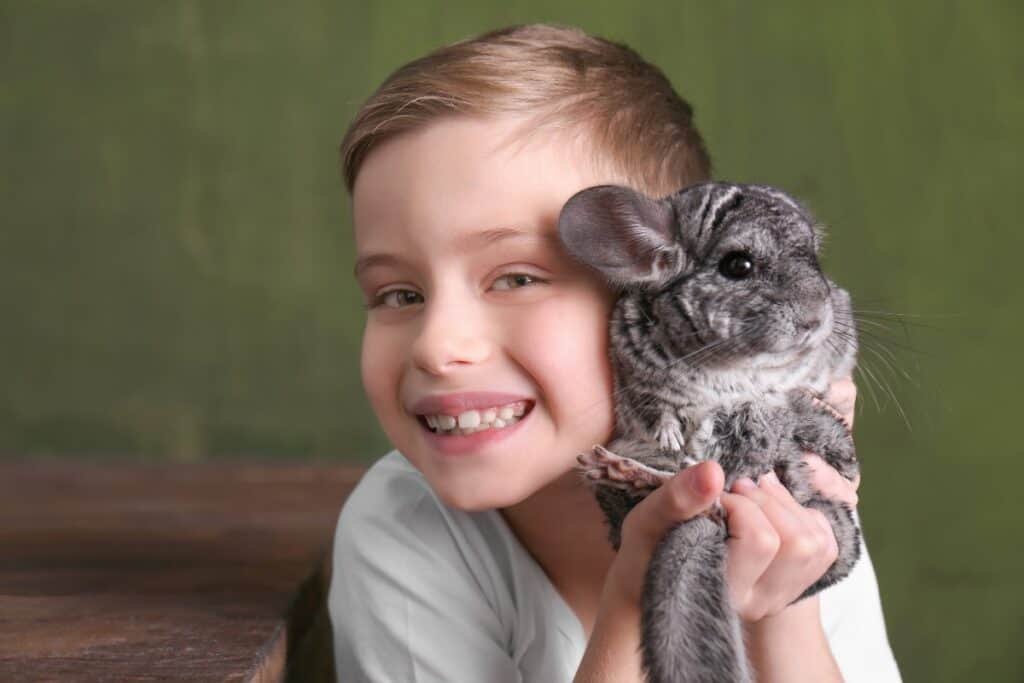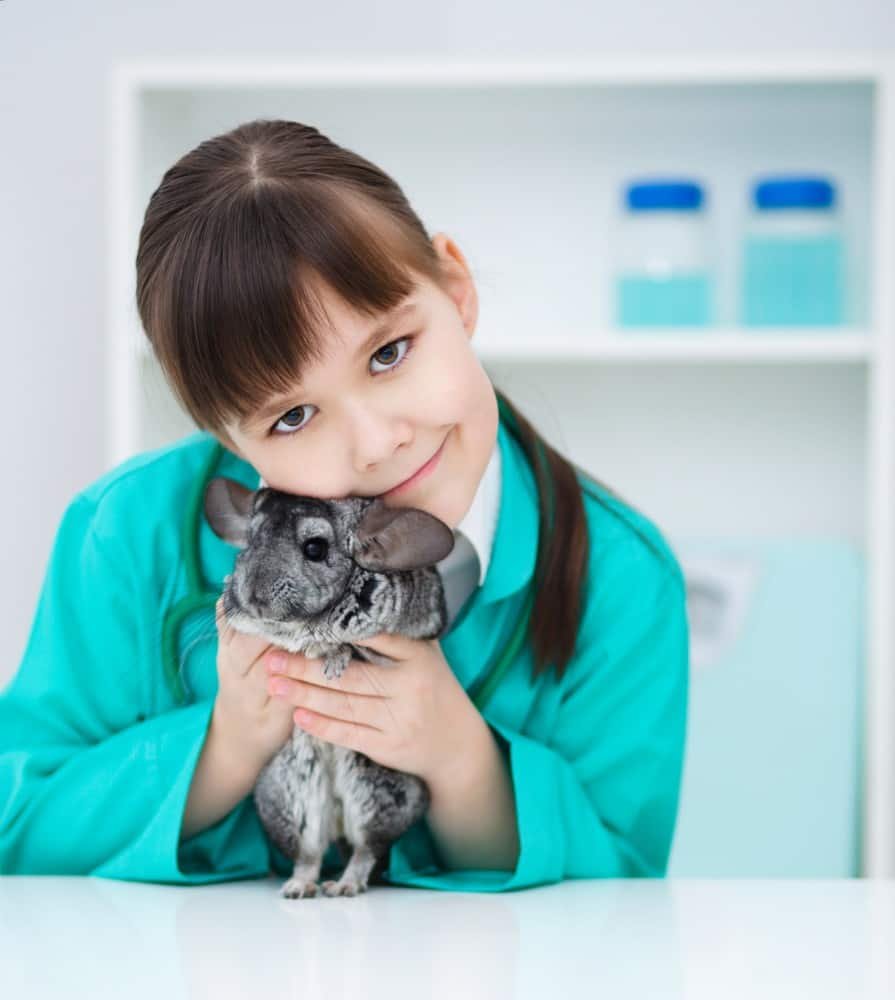Chinchillas are a small South American rodent from the Andean Mountains, and they’re rising in popularity as a potential pet. As a result, many parents may be starting to wonder if a chinchilla would make a wise addition to their household. After all, they do look very cute and cuddly, and could make an ideal pet for their children.
Chinchillas make great pets for mature 9-11-year-old children, and are also suitable for younger children if the adults are prepared to shoulder most of the responsibility for their care.
The prevailing view from experts is that chinchillas do not make good pets for 9- to 11-year-olds. However, many chinchilla enthusiasts and owners disagree. Depending on the age and maturity of the child, and with the proper precautions and care, a chinchilla can be a wonderful pet for a child.
With that in mind, potential chinchilla parents need to develop a plan to make sure the chinchilla is going to be well-cared for by their pre-teen child. Read on to learn some of the many things to consider.

What Are The Potential Problems With Chinchillas As Pets For Children?
As noted above, opinions vary on whether or not chinchillas make good pets for children. Some experts and activists argue that the species isn’t suitable as a pet for tweens (or maybe as a pet at all).
- Personality and behavior – Some experts think that the animal’s behavior makes such a pairing undesirable. For example, according to Live Science
 , chinchillas “… do not make good pets for small children … because chinchillas are hyperactive and high-strung [1]
, chinchillas “… do not make good pets for small children … because chinchillas are hyperactive and high-strung [1] - Questions about captivity – Some animal rights organizations frown on the domestication of the species, citing their fragility and the unnatural stresses often inflicted on them by captivity. For example, OneKindPlanet
 says, “Chinchillas are sometimes kept as pets…(but we) are concerned that their needs cannot be met fully in captivity. [2]”
says, “Chinchillas are sometimes kept as pets…(but we) are concerned that their needs cannot be met fully in captivity. [2]” - Lifespan – It may sound strange to cite a pet’s long life as a reason not to have one, but some kids may outgrow their interest in a chinchilla over time. These animals can live 15-20 years in captivity. If the family isn’t prepared for that, this may not be a good match.
So, keep those three things in mind when considering whether or not to get a chinchilla as a pet for your child. They are a little hard to handle, and they can be fragile. Other reasons to take into account when deciding whether chinchillas are suitable for kids are described here .
.
Why Are Chinchillas Good Pets For Children?
In spite of the advice of the so-called experts, many people keep chinchillas as pets and find the experience richly rewarding for both them and their children.
- Education and training. You must be diligent and teach the child how to care for and deal with the animal. Children must be taught how to properly hold and handle a chinchilla.
- Patience and slow socialization. The bond between animal and owner, whether child or adult, must be built up over time, so the chinchilla becomes comfortable and trusts the child. Chinchillas must learn the new smells and the new noises (such as a person’s voice) of their new home.
- Let the chinchilla get used to its new home. Avoid overstimulating the chinchilla, as they’re usually shy and timid at first. Some chinchilla owners suggest that it is wise to keep the chinchilla in its cage for the first couple of weeks, in order to let them slowly acclimate to their new environment.
When you, as a watchful parent and guardian, deems the chinchilla is ready, you can let them out of their cage. Just make sure you carefully monitor the child and the chinchilla as they play.
What Are Chinchillas Like?

Chinchillas originate from the Andean Mountains in South America. They are a small rodent with a long bushy tail and soft fur that was originally grey in color but, due to breeding practices, is now available in a wide variety of other colors from silver to beige to black and more.
They are closely related to rabbits, guinea pigs, and porcupines, and these are some of their characteristics:
- Their bodies are small and fragile. Chinchillas are small animals with a body that is roughly a foot long and a tail that can add up to another six inches. They weigh from a little over a pound to just under two pounds.
- They are active creatures. Chinchillas are extremely agile animals that can jump as high as six feet in the air.
- They can be super cuddly when comfortable. Chinchillas have remarkably soft fur. It is perfect for stroking and cuddling, and it is one of the factors that makes a chinchilla an attractive, snuggly pet.
- They are sociable. As mentioned previously, chinchillas tend to be timid – they need time to get to know their owners. Once they do, however, they are very sociable.
- They are curious. Chinchillas are very curious and inquisitive creatures. Once they adjust, they’ll likely love to explore their new surroundings
As you can see, they have some very good traits for a pet, as long as the new owner is ready to keep up with their specific requirements, and care for them.
How Do You Care For A Chinchilla?

Chinchillas have been said to be low-cost, low-maintenance pets. And yet, as mentioned above, they are fragile, so they need a certain level of delicate care.
- Temperature resilience: As they originate from high in the Andes Mountains, they are highly tolerant of cold temperatures. Heat, however, can become a problem with them. They start suffering the ill effects of high heat at temperatures above 80 degrees F. Wikihow has a great article on how to recognize and deal with heatstroke
 .
. - Activity cycle: Chinchillas are nocturnal. In other words, they sleep during the day and are active at night. Specifically, they are crepuscular, and are most active at dusk and at dawn.
- Diet: Chinchillas are herbivores, and should only eat plant material. They require a high fiber, low carbohydrate, and low-fat diet [3]. They hold their food in their little front paws to eat.
- Bathing and hygiene: One unique trait of chinchillas is how they clean themselves. They take dust baths, which basically entails bathing in fine volcanic ash. This is specialist ash, and can likely be found at any pet shop that deals with chinchillas – sand must never be used!
- First contact: One of the most important points to remember about chinchilla care is their timidity and shyness. You should not try to force contact with a chinchilla; instead, you should let it approach you first. This is an important lesson to instill in your children, particularly the ones who will be taking care of the creature. If a child learns to stay calm around the chinchilla, there should be few problems. Stress that they shouldn’t grab the animal with excessive force.
- Treating: As with all pets, you shouldn’t give too many treats to a chinchilla. For chinchillas, treats should make up less than 10% of their diet – this is due to the delicate digestive system, and the fact that they can develop diabetes. This is something that children may find more difficult to understand, so it’s usually a good idea to just set a maximum number of treats per day for the pet (generally 1-3).
These are the basics, and whilst they’re not too much more difficult than other pets, you’ll need to remember that chinchillas do have some specific needs to keep in mind.
Can A 9- To 11-Year-Old Child Care For A Chinchilla?

If you keep those points mentioned above in mind, then absolutely a 9- to 11-year-old child can care for a chinchilla. They will fall in love with their chinchilla. and the chinchilla will bond with them in turn. Here are some kid-specific reasons a chinchilla can be a great pet:
- It sleeps while your child is in school, so it will be all rested when they come home.
- It has an unusual and fascinating bathing routine that is fun for kids to watch.
- It’s not too difficult to feed.
- It is out and out adorable.
Just remember to keep the chinchilla from getting too warm, handle it gently, and don’t rush the introductions. I’ve written some additional information on chinchillas and kids here .
.
In short, if you have an attentive, patient, and compassionate pre-teen who loves caring for a cuddly creature, they should get along very well with a chinchilla.
What Can You Expect From A Chinchilla?
All in all, a chinchilla has the potential to be a great choice for a pet. Here are a few more pointers and specifics to remember:
| Personalities of Chinchillas | Timid and shy. Prefer simple, repeated routines. Intelligent, and can be taught to play. Very social animals, living in colonies of over 100 individuals in the wild. |
| Notes on the Female | These are the dominant gender, and can be aggressive. Aggressive with each other in the wild. Aggressive toward males when they mate. |
| Breeding | Have babies (called kits) up to 2x a year. Babies become fertile at 8 months. |
| Housing | House separately (see female aggression above). House in well-ventilated cages. Keep cool and dry. Temperature range between 60 and 70 F. Avoid fans and draughts. |
| Diet | Hay, Dried fruit, Dried nuts, Small amounts of carrots and green vegetables (about 10 percent of diet), Water from a regular bottle with a sipper tube. |
| Lifespan | Averages around 15 years but can be as high as 20 years or more. |
Those are some of the things you should keep in mind if you want to purchase a chinchilla as a pet for your preteen. Look the above table over and study it well. And when you are ready, maybe it’s time to acquire a chinchilla.
Note I say acquire – this is because you should never buy a chinchilla from a pet store (see my article here on buying from PetSmart), but instead should look to rescue or adopt, or buy from a reputable dealer (who will take the time to let you get to know the chinchilla, and vice versa).
on buying from PetSmart), but instead should look to rescue or adopt, or buy from a reputable dealer (who will take the time to let you get to know the chinchilla, and vice versa).
In summary, chinchillas can be great pets for 9 to 11-year-old children. It takes a little care and planning, but it can be done, provided the child in question has a certain level of maturity and an adequate attention span. Also, you, as the parent, should be prepared to serve as back-up and maybe even the ultimate caretaker at a later point in the future.
Additional sources: Chinchilla Chronicles [4], and Yahoo questions [5]
Sources

